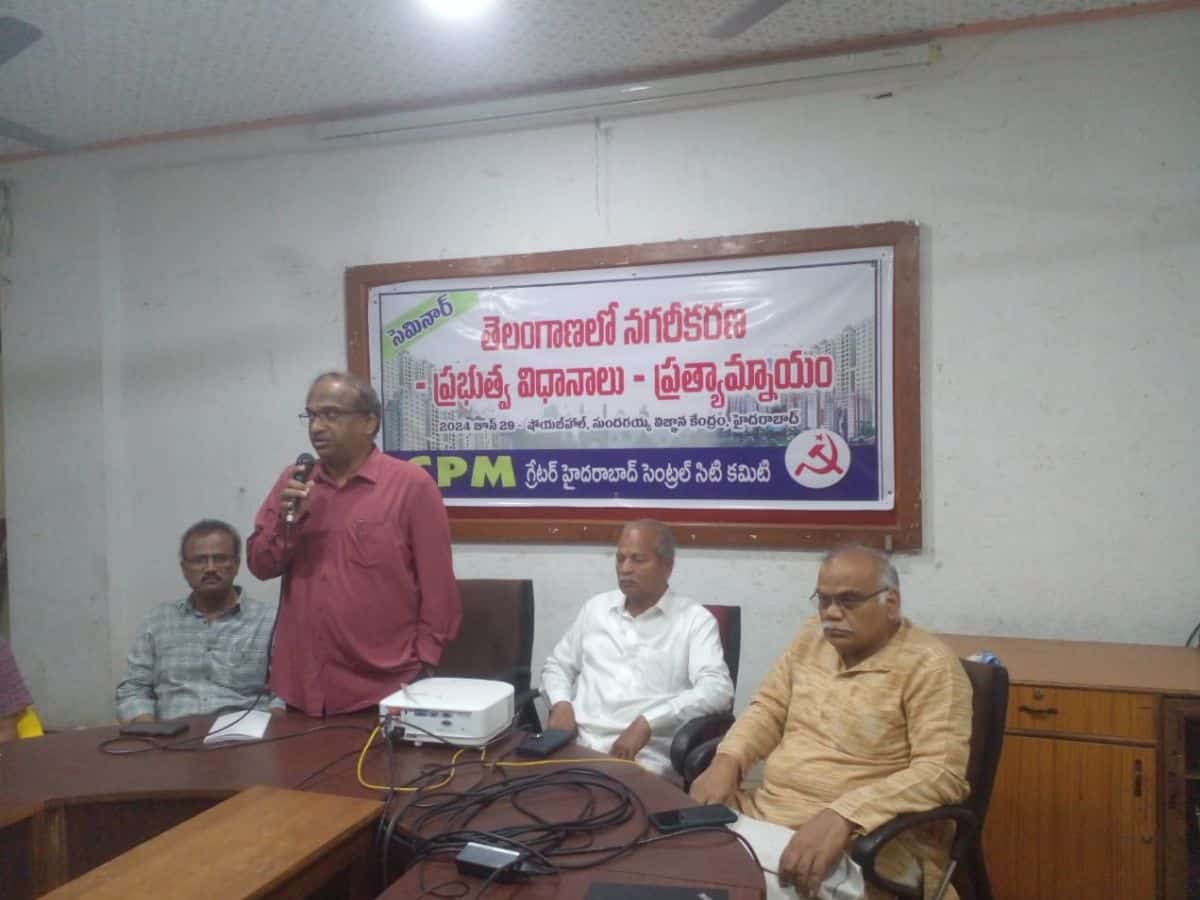Hyderabad: Former MLC and professor K Nageshwar has stressed the need for the constitution of Telangana Urban Commission on the lines of Kerala Urban Commission, which can create an intervention in urban planning and show an alternative model of development for Hyderabad.
He was speaking at a seminar organised by CPM Hyderabad Central Committee on the topic “Urbanisation in Telangana, government policies, alternatives” at Sundarayya Vignana Kendram in Baghlingampally on Saturday.
Talking about the need to view urbanisation as a positive phenomenon which promotes innovation and contributes to the economy, Nageshwar said that there was a need for deviating away from the “real estate oriented growth model” and “ease of doing business model,” to “ease of living model.”
For this to happen, he said that a symbiotic relationship between the profited class and the working class was essential.
The threat of ‘ghettoization’
Observing that there was a huge disparity between the demand and supply for huge infrastructure like drinking water, sanitation, transportation and other needs in a rapid urbanisation scenario prevailing in the city, he cautioned that there was a scope for “ghettoization” of the city, as caste and class division has already been taking place.
“There is a difference happening in the demography of cities. Like in the US where the profited class lives in the suburban areas and the poor live in downtown. A similar situation can be seen in Hyderabad, where the profited castes and classes have been moving away to Necropolis, Kokapet and other areas, whereas the working classes and the poor are living in the slums,” he observed, noting that infrastructure needed to be created in the areas where the working and lower classes thrive, failing which it will some day lead to the disturbance of peace.
Estimates and solutions for creating social infrastructure
Pointing out the estimation of the World Bank that 70 lakh crore was needed to create social infrastructure in the cities across the country, and as per Mc Kinsey and Company, 90 lakh crore was needed; Prof Nageshwar said that whenever the idea of urban reforms came, policy-makers have always tried to increase the property tax, which puts the burden on the people.
Instead, he said that as per KC Sivaramakrishnan Committee’s recommendations, 10% of the income tax collected could be put in the budget by the Centre, for creation of capital infrastructure (urban social infrastructure) which is favourable for the working class.
Land pool for agricultural conservation
Drawing a contrast between ‘building with nature’ and ‘building by destroying nature,’ he suggested that a pool of 1,800 acres of agriculture conservation land which has been under threat of being grabbed by land sharks in and around Hyderabad, could be used to grow vegetables and fruits in them to meet the consumption needs of the city-dwellers. He also suggested that the government could lease-in vacant lands and use it for this purpose.
“Not only the health of the people in Hyderabad can improve through this, but also tens of thousands can get a livelihood in those lands,” he asserted, referring to the recommendations of the Food and Agriculture Organisation (FAO).
Affordable and reliable transport
Stressing the need for the government to provide affordable and reliable public transport, he noted that the per capita road space in bus transport was much less than the per capita road space in car transport.
“Motorable transport being used by 70% of the population in the cities is causing 60% of pollution. Not even 30% of people are using public transport. Only if the people believe that the mode of public transportation reaches on time and is affordable, then they will prefer it,” he said.
Land pattas to slum dwellers for in-situ development
Talking about urban housing, he opined that while the sales of villas and high-end houses were increasing, the sale of affordable housing has seen a dip, just like the high-end cars witnessing a jump in sales whereas the sale of budget cars were witnessing a slump.
“While quite a few models have been unsuccessfully been tried in building housing for the poor, the right model being perceived to be beneficial is giving pattas to the slum-dwellers within their land. Then civic infrastructure will be created there, and because they will take ownership of their land, they will invest on it,” he said, suggesting changes to the present urban land use policy.
Food security model in cities
Also pointing out the Urban Food Security model being implemented in Kochi of Kerala, he felt that Rs 10 meal canteens being run by the State government could be improvised by introducing more dishes, and if possible introduction of white meat, and also parcel service, which could benefit not only the poor, but also attract the middle-class.
An alternative plan
“Those in power should choose whether the city desires profit or people, profited people or the common people,” he said, suggesting the CPM think-tanks to come up with a document called ‘Hyderabad- an alternative plan,’ which could be placed before the State government, and public hearings are held to see how the city could be developed from the people’s perspective, especially by having representation from the working class in that effort.







